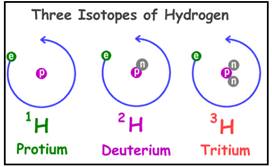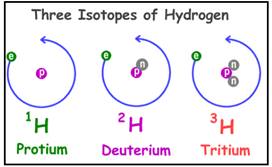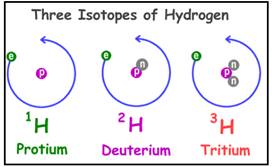
Concept explainers
(a)
Interpretation:
Two samples of water, each made up of different isotopes of hydrogen. One has
Concept introductio n:
Isotopes are defined as the element that has same
Example:
Isotopes of hydrogen are

Figure 1
(b)
Interpretation:
Two samples of water, each made up of different isotopes of hydrogen. One has
Concept introductio n:
Isotopes are defined as the element that has same atomic number (Z) but different mass number (A).
Example:
Isotopes of hydrogen are

Figure 1
(c)
Interpretation:
Two samples of water, each made up of different isotopes of hydrogen. One has
Concept introductio n:
Isotopes are defined as the element that has same atomic number (Z) but different mass number (A).
Example:
Isotopes of hydrogen are

Figure 1
Want to see the full answer?
Check out a sample textbook solution
Chapter 20 Solutions
General Chemistry
- Draw and name the R groups of all 20 amino acids.arrow_forward3. Two solutions are prepared using the same solute: Solution A: 0.14 g of the solute dissolves in 15.4 g of t-butanol Solution B: 0.17 g of the solute dissolves in 12.7 g of cyclohexane Which solution has the greatest freezing point change? Show calculations and explain.arrow_forward2. Give the ground state electron configuration (e.g., 02s² σ*2s² П 2p²) for these molecules and deduce its bond order. Ground State Configuration Bond Order H2+ 02- N2arrow_forward
- 1. This experiment is more about understanding the colligative properties of a solution rather than the determination of the molar mass of a solid. a. Define colligative properties. b. Which of the following solutes has the greatest effect on the colligative properties for a given mass of pure water? Explain. (i) 0.01 mol of CaCl2 (ii) 0.01 mol of KNO3 (iii) 0.01 mol of CO(NH2)2 (an electrolyte) (an electrolyte) (a nonelectrolyte)arrow_forward5. b. For Trials 2 and 3, the molar mass of the solute was 151 g/mol and 143 g/mol respectively. a. What is the average molar mass of the solute ? b. What are the standard deviation and the relative standard deviation (%RSD) for the molar mass of the solute ?arrow_forwardShow work. Don't give Ai generated solutionarrow_forward
- 2. Explain why ice cubes formed from water of a glacier freeze at a higher temperature than ice cubes formed from water of an under- ground aquifer. Photodynamic/iStockphotoarrow_forwardShow reaction mechanism. don't give Ai generated solutionarrow_forward7. Draw the Lewis structures and molecular orbital diagrams for CO and NO. What are their bond orders? Are the molecular orbital diagrams similar to their Lewis structures? Explain. CO Lewis Structure NO Lewis Structure CO Bond Order NO Bond Order NO Molecular Orbital Diagram CO Molecular Orbital Diagramarrow_forward
- 5. The existence of compounds of the noble gases was once a great surprise and stimulated a great deal of theoretical work. Label the molecular orbital diagram for XeF (include atom chemical symbol, atomic orbitals, and molecular orbitals) and deduce its ground state electron configuration. Is XeF likely to have a shorter bond length than XeF+? Bond Order XeF XeF+arrow_forward6. Draw the molecular orbital diagram shown to determine which of the following is paramagnetic. B22+ B22+, B2, C22, B22 and N22+ Molecular Orbital Diagram B2 C22- B22- N22+ Which molecule is paramagnetic?arrow_forward3. Put the following species in order of increasing bond length by using molecular orbital diagrams and calculating their bond orders: F2, F2, F2+ Molecular Orbital Diagram F2 F2 F2+ Bond Order Shortest bond: Longest bondarrow_forward
 Chemistry for Engineering StudentsChemistryISBN:9781337398909Author:Lawrence S. Brown, Tom HolmePublisher:Cengage Learning
Chemistry for Engineering StudentsChemistryISBN:9781337398909Author:Lawrence S. Brown, Tom HolmePublisher:Cengage Learning Introduction to General, Organic and BiochemistryChemistryISBN:9781285869759Author:Frederick A. Bettelheim, William H. Brown, Mary K. Campbell, Shawn O. Farrell, Omar TorresPublisher:Cengage Learning
Introduction to General, Organic and BiochemistryChemistryISBN:9781285869759Author:Frederick A. Bettelheim, William H. Brown, Mary K. Campbell, Shawn O. Farrell, Omar TorresPublisher:Cengage Learning General Chemistry - Standalone book (MindTap Cour...ChemistryISBN:9781305580343Author:Steven D. Gammon, Ebbing, Darrell Ebbing, Steven D., Darrell; Gammon, Darrell Ebbing; Steven D. Gammon, Darrell D.; Gammon, Ebbing; Steven D. Gammon; DarrellPublisher:Cengage Learning
General Chemistry - Standalone book (MindTap Cour...ChemistryISBN:9781305580343Author:Steven D. Gammon, Ebbing, Darrell Ebbing, Steven D., Darrell; Gammon, Darrell Ebbing; Steven D. Gammon, Darrell D.; Gammon, Ebbing; Steven D. Gammon; DarrellPublisher:Cengage Learning Chemistry: Matter and ChangeChemistryISBN:9780078746376Author:Dinah Zike, Laurel Dingrando, Nicholas Hainen, Cheryl WistromPublisher:Glencoe/McGraw-Hill School Pub Co
Chemistry: Matter and ChangeChemistryISBN:9780078746376Author:Dinah Zike, Laurel Dingrando, Nicholas Hainen, Cheryl WistromPublisher:Glencoe/McGraw-Hill School Pub Co Introductory Chemistry: A FoundationChemistryISBN:9781337399425Author:Steven S. Zumdahl, Donald J. DeCostePublisher:Cengage Learning
Introductory Chemistry: A FoundationChemistryISBN:9781337399425Author:Steven S. Zumdahl, Donald J. DeCostePublisher:Cengage Learning





